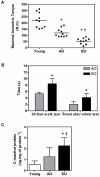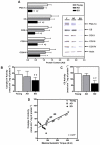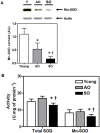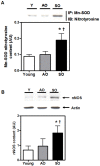Aberrant mitochondrial homeostasis in the skeletal muscle of sedentary older adults
- PMID: 20520725
- PMCID: PMC2875392
- DOI: 10.1371/journal.pone.0010778
Aberrant mitochondrial homeostasis in the skeletal muscle of sedentary older adults
Abstract
The role of mitochondrial dysfunction and oxidative stress has been extensively characterized in the aetiology of sarcopenia (aging-associated loss of muscle mass) and muscle wasting as a result of muscle disuse. What remains less clear is whether the decline in skeletal muscle mitochondrial oxidative capacity is purely a function of the aging process or if the sedentary lifestyle of older adult subjects has confounded previous reports. The objective of the present study was to investigate if a recreationally active lifestyle in older adults can conserve skeletal muscle strength and functionality, chronic systemic inflammation, mitochondrial biogenesis and oxidative capacity, and cellular antioxidant capacity. To that end, muscle biopsies were taken from the vastus lateralis of young and age-matched recreationally active older and sedentary older men and women (N = 10/group; female symbol = male symbol). We show that a physically active lifestyle is associated with the partial compensatory preservation of mitochondrial biogenesis, and cellular oxidative and antioxidant capacity in skeletal muscle of older adults. Conversely a sedentary lifestyle, associated with osteoarthritis-mediated physical inactivity, is associated with reduced mitochondrial function, dysregulation of cellular redox status and chronic systemic inflammation that renders the skeletal muscle intracellular environment prone to reactive oxygen species-mediated toxicity. We propose that an active lifestyle is an important determinant of quality of life and molecular progression of aging in skeletal muscle of the elderly, and is a viable therapy for attenuating and/or reversing skeletal muscle strength declines and mitochondrial abnormalities associated with aging.
Conflict of interest statement
Figures




References
-
- Manton KG, Vaupel JW. Survival after the age of 80 in the United States, Sweden, France, England, and Japan. N Engl J Med. 1995;333:1232–1235. - PubMed
-
- Strawbridge WJ, Cohen RD, Shema SJ, Kaplan GA. Successful aging: predictors and associated activities. Am J Epidemiol. 1996;144:135–141. - PubMed
-
- Hepple RT. Sarcopenia–a critical perspective. 2003. Sci Aging Knowledge Environ 2003: pe31. - PubMed
-
- Melton LJ, 3rd, Khosla S, Riggs BL. Epidemiology of sarcopenia. Mayo Clin Proc. 2000;75(Suppl):S10–12; discussion S12-13. - PubMed
Publication types
MeSH terms
Substances
LinkOut - more resources
Full Text Sources
Other Literature Sources
Medical

